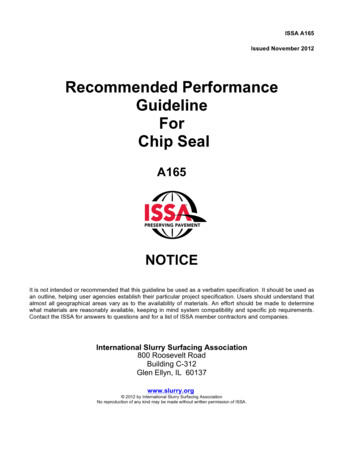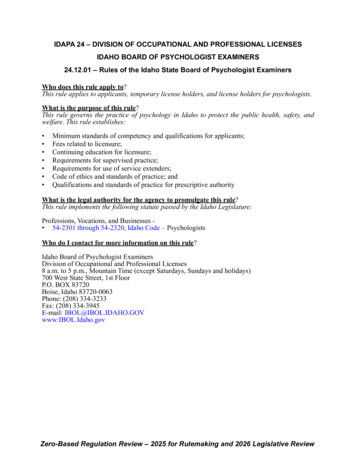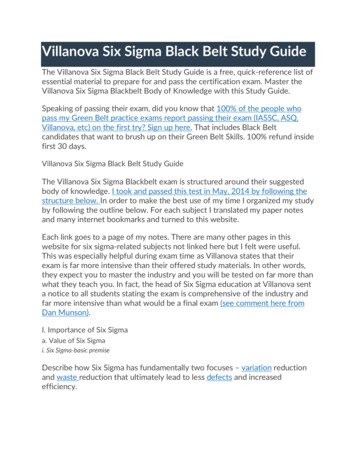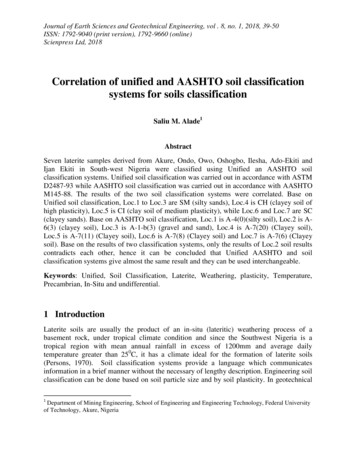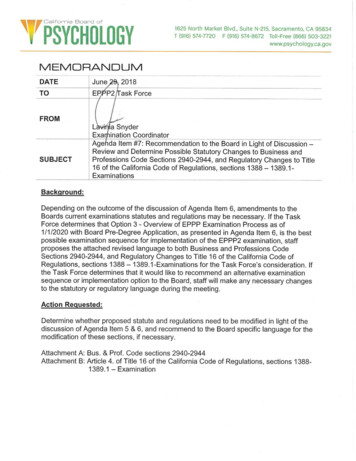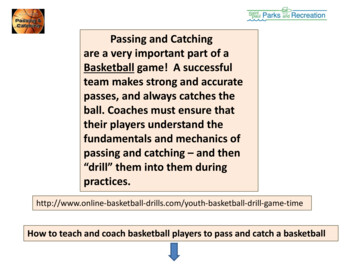
Transcription
Passing and Catchingare a very important part of aBasketball game! A successfulteam makes strong and accuratepasses, and always catches theball. Coaches must ensure thattheir players understand thefundamentals and mechanics ofpassing and catching – and then“drill” them into them s.com/youth-basketball-drill-game-timeHow to teach and coach basketball players to pass and catch a basketball
Catching the BallA pass is only good if it can be caught. Therefore, your players should always be ready to catch theball. They need to anticipate both when and where the pass will be thrown. In order to catch theball they should: Get as open as possible and present a good target to the passer.To receive the ball:Keep hands out from the chest.Keep fingers pointed up and spread comfortably, with the thumbs almost touching each other.This position enables them to immediately get a good hold on the ball.Between the passer and the receiver there is an unspoken signal to pass the ball: the raisedand open hands of the receiver. This tells the passer, "I'm open! Give me the ball!Not every pass will be perfect. They must be ready to move from side to side for a poorly thrown ordeflected pass.Keep eyes on the ball from the time it leaves the passer's hands until they actually touch theball. Taking eyes off the ball for only a split-second can cause a fumbled pass.Step toward the ball as it comes with arms out to decrease the length of the pass. Also,this prevents the defense from stepping in front and stealing the ball.After the ball hits their fingers, bend elbows slightly and bring the ball in toward their chest.This cushions the impact of the pass and gives better control of the ball.Now, that they have the ball at chest level, they are in a position to pass or shoot quickly.
a) The receiver must be ready to catch the ball by showing a “target” (have their hands up and readyto receive the ball at all times).b) Players should not let the ball hit their body, they must always catch the ball with their hands.c) Players must “look the ball” into their hands each and every time they catch the ball. The youngerplayers tend to turn their heads when they are about to receive the pass.d) When catching the ball a player must firmly grab and hold the ball – be strong when holding thebasketball.e) Players should “step” towards the ball to catch it (never step backwards). Meet the pass, come tothe pass, step to the pass!
Passing Sets Up Winning ShotsPassing is the quickest and most effectiveway to get the ball from player to playerand move it around the court. The morepasses that are made by the offense, themore you will challenge the defense. Itkeeps them scrambling, frustrated, andtired. The perfect end result of a series ofwell-executed passes will be to an openman close to the basket. He can take theball and easily score.
The Five Passing LanesEach game situation presents the possibility for one perfect pass.Imagine yourself faced by adefender crouched over in good defensive position. What you shouldnow see is not just thisplayer, but actually, five possible passing lanes. These five lanes are:1.Over the top of the defender's head.2.Near the left side of his head.3.Near the right side of his head.4.Near his right leg.5.Near his left leg.If you are well guarded by your man you won't be able to pass the ball immediately where youwant to. In cases like this, fake with the ball. Fake with your body; or, fake with your body andthe ball. Once the defender goes for the fake, pass through one of the five lanes.
Principles of Passing the Basketball:Passing the basketball is an “offensive” skill that requires lots of practice. Ensure that the playerspractice proper passing techniques / mechanics at all times.a) Players should try to make the “shortest” pass, usually a coach will refer to this as “make theeasiest” pass. The longer passes are not as accurate and tend to get “stolen” by the defense.b) Players should pass the ball to the “receivers” hands (the target).c) Teach your players to pass with their thumbs starting behind the ball and ending with their thumbspointing downwards.d) Players should always make “strong” passes, “soft” passes will get stolen or deflected by thedefense.e) When passing the ball, the pass should be thrown to the “opposite” side of the receivers defender(don’t make it easy for the defender to steal the pass).
Passing Mechanics:Teach your players to pass with their thumbs starting behind the ball and ending withtheir thumbs pointing downwards – see pictures below. This is a very basic, butimportant skill to learn, coaches need to just “drill” it into your players until they arecomfortable with it.Notice how thethumbs are pointingdownward after theball is passed.Player has a firmgrip on the balland is ready topass the ball Player stepstowards theteammate theyare passing to Thumbs aredownward afterthe ball isreleased
The Two-Handed Chest PassThe chest pass is the most common pass they will throw in a game when there isn't a defensiveplayer between them and a teammate. To execute this pass, start with the ball held in two handschest- high and close to the body. Elbows should be tucked in and fingers spread around the ball withthumbs up. Don't spread your fingers out too far because this positioning will prevent you frommaking a quick pass. As they hold the ball, wrists should be pointed upward. Holding themdownward will force them, first, to turn them up before the pass. This is an unnecessary extramovement that only delays the pass. When they are about to make the pass, step in the direction oftheir pass. Moving like this gives body balance and gives the pass more power and speed. Don'toverextend the step, because this tends to take away some balance.As their arms stretch out to their full length, rotate elbows and wrists outward so that the hands endup in a thumbs- downward, palms-out position. Release the ball with a snap of your wrist.Spin the ball with the index fingers, middle fingers, and thumbs as it leaves the hands. This spin onthe ball causes it to travel in a straighter line. This type of pass is easier to catch than a "flat spinless“pass.
The Two-Handed Bounce PassThe basic mechanics of the bounce pass are the same as those of the chest pass; however, thegame situation for each of the passes are different. A bounce pass is a good one to use on a backdoor play. It is also the pass to use when passing to a teammate, guarded from behind in the lowpost, or in other situations when a defender is between the passer and the receiver. Starting withthe same position as the two-handed chest pass, take a strong step in the direction of the receiver.Quickly extend the arms and palms outward. Backspin is put on the ball as it go from thumbsup to a thumbs down release position. This backspin makes the ball easier to catch. The ball musthit the floor at least three-quarters of the distance to your receiver. It should come up to him/herat the thighs and waist.
The Two-Handed Overhead PassThe overhead pass is commonly used for moving the ball around the perimeter, as a skip pass, apass into the post area, and as an outlet pass. When they make this pass, always aim the ball alittle over the head of the receiver. To make an overhead pass, hold the ball over the head andslightly back of the center of the head. Don't hold the ball BEHIND the head. This wastesmovement and time. Fingers should be spread firmly around the ball, thumbs a couple of inchesapart at the bottom of the ball. This pass gets its power from the flick of the wrists and fingers. Asthe passer steps toward the receiver, snap the wrists and rotate both arms and palms outward.Hands should end with the fingers pointing upward.
The Lateral PassThe starting position is the same as the two-handed chest pass. With the defender standing in frontof the passer, the passer steps across his/her body with the foot opposite the ball. This protects theball. Bring the ball to their side and extend arms. Quickly cock the outside wrist, drop the helper hand,and snap the ball to the receiver. A variation of this pass is the lateral bounce pass made with one orboth hands. If this pass is used, the ball must be bounced to a spot, at least, three-quarters of thedistance to the receiver.The Push PassThe push pass is a quick pass made with one hand. The pass originates near the ear and relies onthe elbow being bent for its power. It can either be a straight or a lob pass. This depends upon thedefensive alignment.The Behind-The-Back PassThis pass used to be considered a "show-off" pass; however, it now has become a normal offensiveweapon. Still, it MUST NOT be abused. To make the pass, hold the ball with two hands. As the ball isbrought back around the hip, the helping hand drops off. The passing hand is on the side of the balland must thrust the ball behind the back. The movement ends with the passing hand near theopposite hip, with the fingers pointing in the direction of the pass.
The Baseball PassThis is a long-distance pass, usually thrown more than half- court. Generally, one baseball pass to aplayer headed down-court ahead of anyone else, is all that's needed for a quick two points. Tomake the baseball pass, keep both hands on the ball as long as possible. This gives bettercontrol and will help enable to stop the pass at the last moment, if needed.Plant back foot and bring the ball back above the shoulder and near the ear on the throwingside. The arm must be bent at a 45-degree angle. The upper arm should be parallel to the floor.This position will enable the passer to throw a quick, straight, and hard pass. Step toward thedirection of the intended pass with the foot opposite the throwing arm. Make an overhead throw,snapping the wrist, and follow through with the arm fully extended. Remember to put a backwardrotation on the ball to make it go straight.The Hand-Off PassThis is a pass that doesn't require an extension of the arm. It is used to give the ball to a teammatewho is either cutting or circling behind the passer. Have one arm up and the ball laying on the palmof the other hand. Simply toss or flip it to the receiver. Another variation of this is to turn the bodytoward the receiver, or else, make a complete turn, face the receiver and give him/her the ball.The Hook PassWhen closely guarded, hold the ball at shoulder level, elbows flared outward to protect theball. Start to lift the ball up with two hands, with the wrist of the outside hand flexed. Drop thehelping hand to face level. Extend your passing arm over your head with the ball. When you havestretched this arm out completely, flick the ball by snapping your wrist forward.
The Off-The-Dribble PassThis is becoming a pass that is popping up at all levels of basketball. To make this pass work, on thelast dribble, move the dribbling hand to the top quarter of the ball. Combine a lateral movementof the hand and arm, and push the ball forward with a snap of the wrist toward the receiver. Thispass is quick and deceptive. It will usually catch the defensive man by surprise.Passing DrillsPassing, like shooting, requires constant practice. Ifyou will regularly work on the fundamentals ofpassing, your team’s passing mechanics will improve.However, it's only through team practice sessions andgames, with coaches watching, that your players willreally learn WHEN to pass and HOW to get the passover, under, or through the defender.Such situations will develop and sharpen passing skillsthe most, turning passing mechanics into valuable oncourt skills
Notes / Teaching Points:1. Stress to the players that all passes should be “strong” and “accurate.” No “soft”passes allowed.2. Passers should always find a target to pass to before passing (which is usually thereceiver’s hands).3. When getting ready to catch a pass, players should “look” the ball into their hands,and never lose eye contact with the ball. Coaches should demonstrate how the ballcould hit a player in the nose or face when the player that is attempting to catch a passtakes their eye off the ball.4. Coaches should always ensure that the players are practicing the correct techniques/ mechanics and not forming bad habits that will be hard to break later.5. Keep the passing drills interesting and fun! It’s always better when the players cometo practices excited about the drills you are running. There are tons of passing drillsavailable, but the one that helps the younger players the most is the “Weave” drill. Ithelps with catching, passing, coordination, accuracy, and coordination (plus it is a lot offun for the players).
Basic 3-Player Weave ShootingPass and go behind the personyou passed to. Shooterretrieves the ball and playersreturn running outside thecourt and the next group of 3runs the weave.OR(After they become proficient)Pass and go behind the personyou passed to. Shooterretrieves the ball, becomes thecenter person and the samegroup runs the weave back tothe other end of the court
A pass is only good if it can be caught. Therefore, your players should always be ready to catch the ball. They need to anticipate both when and where the pass will be thrown. In order to catch the ball they should: Get as open as possible and present a good target to the passer. To receive
